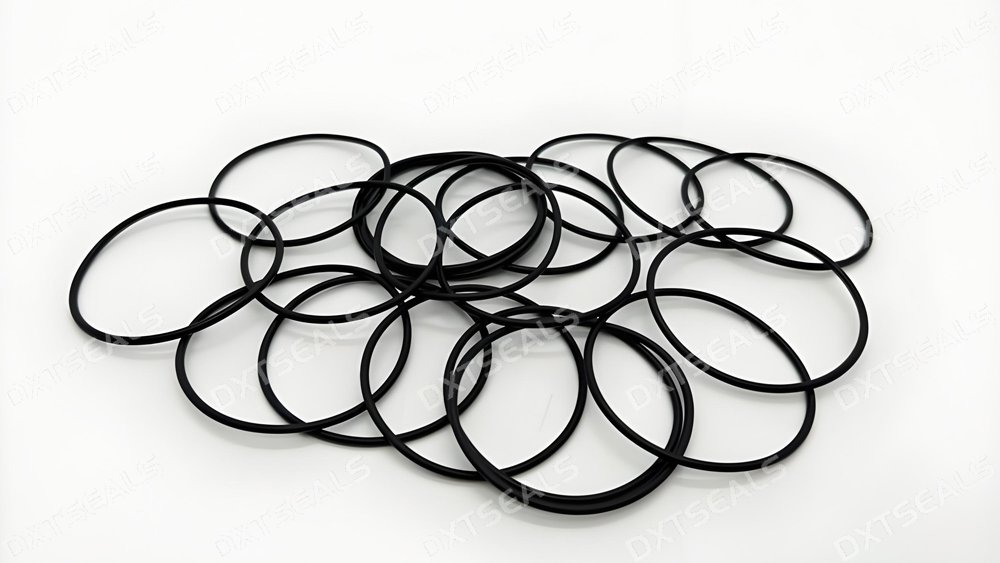
O-rings are one of the most widely used sealing elements in hydraulic, pneumatic, chemical, and mechanical systems. Choosing the wrong material can lead to premature wear, swelling, hardening, or even complete seal failure.
In this guide, DXTSEALS explains how to select the optimal O-ring material based on working medium, temperature, and pressure to ensure reliable performance and longer service life.
🔍 Step 1 – Identify the Working Medium
The compatibility of the O-ring material with the fluid or gas it will contact is the first priority.
| Material | Chemical Resistance Highlights | Not Recommended For |
|---|---|---|
| NBR (Nitrile) | Excellent resistance to petroleum-based oils, fuels, water, hydraulic fluids. | Strong acids, ozone, ketones. |
| FKM (Viton®) | Outstanding resistance to oils, fuels, solvents, chemicals. | Low temperatures below -20°C. |
| EPDM | Excellent for water, steam, alcohols, brake fluids. | Petroleum oils, fuels. |
| PTFE | Exceptional chemical resistance to almost all chemicals. | Poor elasticity, needs backup rings in dynamic seals. |
| HNBR | Improved oil, chemical, and heat resistance compared to NBR. | Certain strong acids and oxidizing agents. |
💡 Tip: Always cross-check with a chemical compatibility chart before finalizing the material.
🌡 Step 2 – Consider the Temperature Range
Temperature extremes can cause hardening, softening, or cracking of O-rings.
| Material | Temperature Range (°C) |
|---|---|
| NBR | -40 to +120 |
| FKM | -20 to +200 |
| EPDM | -50 to +150 |
| PTFE | -200 to +260 |
| HNBR | -40 to +150 |
Selection Tip:
-
For high-temperature environments, choose FKM or PTFE.
-
For low-temperature conditions, EPDM or special low-temp NBR is better.
⬆ Step 3 – Evaluate the Pressure Level
While O-rings are pressure-resistant, material hardness (Shore A) and system design play a big role in preventing extrusion and deformation.
-
Low to Medium Pressure (<10 MPa): Most elastomers like NBR, EPDM, FKM are suitable.
-
High Pressure (>20 MPa): Use harder compounds (90 Shore A) or PTFE with backup rings.
-
Pulsating Pressure: Choose materials with good resilience like HNBR or special blends.
📊 Material Selection Quick Reference Table
| Application Condition | Recommended Material |
|---|---|
| Hydraulic oil systems at 80°C | NBR |
| High-temp chemical process (200°C) | FKM or PTFE |
| Steam sealing at 140°C | EPDM |
| Cryogenic pumps (-150°C) | PTFE |
| High-pressure compressor (>20 MPa) | HNBR or PTFE with backup rings |
🛠 Additional Selection Tips
-
Check the hardness rating – higher hardness for high-pressure or extrusion-prone applications.
-
Consider dynamic vs static sealing – PTFE or filled compounds for high wear in dynamic seals.
-
Account for aging factors – UV, ozone, and oxidation resistance if exposed outdoors.
-
Balance cost vs performance – NBR is cost-effective, while FKM offers superior chemical stability.
💡 Conclusion
Choosing the right O-ring material is not just about temperature or pressure—it’s about balancing all operating conditions to achieve reliable, long-term sealing performance.
At DXTSEALS, we offer custom O-ring solutions in NBR, FKM, EPDM, PTFE, HNBR, and more, tailored for specific media, temperature ranges, and pressure ratings. Our technical team can provide material recommendations based on your exact working conditions.
📩 Contact DXTSEALS for professional advice and supply of high-performance O-rings.
